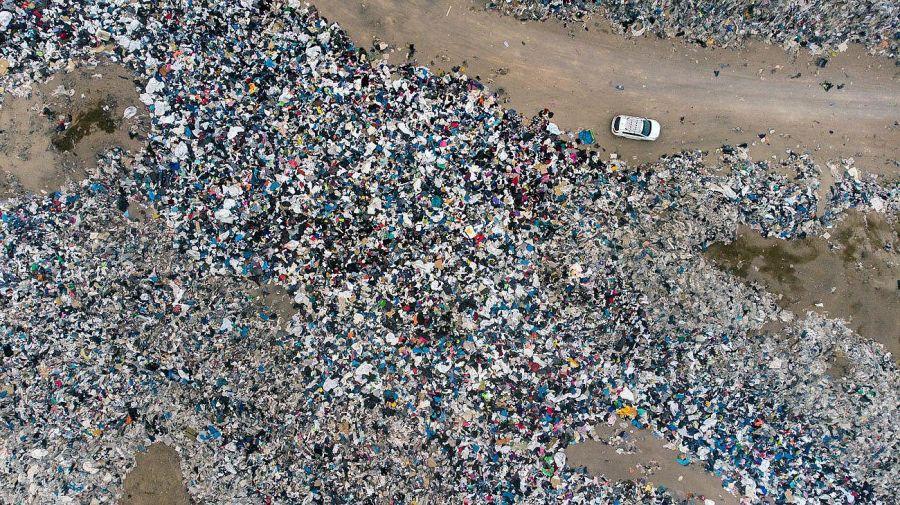Estos días hubo una postal que se viralizó y fue la del desierto de Atacama, donde montañas de ropa se alzan en el desolado paisaje. Se trata de unas 59.000 toneladas anuales que ingresan por la zona franca del puerto de Iquique, a 1.800 km de Santiago.
This is the garbage basket of the clothes made in China or Bangladesh and bought in Berlin or Los Angeles.This “second -hand” clothes or from past seasons of fast fashion chains end as a hidden desert garbage.
In Argentina, there is a resolution that prohibits the entry of used clothes, but expires in 2022.According to the Fashion Revolution Argentina movement, if it is not renewed "we are stepped on in Chile, Guatemala, Mexico and many other countries that buy used clothes from the global north of which only 30% is useful to use again".
Leather and tanneries
One of our country's great dramas in relation to textile industry processes that have serious air quality consequences is the case of leather.It is one of the most significant, its treatment to be used in leather goods and footwear, requires processes that can be highly toxic to people who work in their production, for earth, water and air by emissions that areThey generate ammonia.
Although the equation is not so simple about what to contemplate to measure pollution, there are some agreements.Starting from the manufacture of the material, to its use and its durability, a material that in its manufacture can be harmful, then it can have a longer useful life.Then there is the discussion of what generates less environmental impact, if a material that has a lower useful life but has a less impact on its manufacture or vice versa.It is also true that for all materials.Even some other materials that are apparently friendly also generate great pollution.
Day Two at The #Buildshow2018.Eat and see the credit insurance experts on stand: c323 to understand how to protein ... https: // t.co/xhormveztm
— Xenia Broking Wed Oct 10 08:22:26 +0000 2018

Returning to leather, in Argentina the tanneries and pollution they cause, they are historical.Although they are in different parts of the country, the case of the stream is one of the best known.Over time different causes were added, but its waters are contaminated decades mainly by the activity of tanneries.There are also other resonants such as those of La Rioja where the socio -environmental problem is as serious as.
Some alternatives to leather:
Choose synthetic leather.There are more and more quality and durable alternatives.There are two types, oil -derived plastics whose degradation process is as complex as that of many plastics, although on the other hand they generate less waste and their manufacture is increasingly optimized and achieve better results in resistance and durability.The other option, less frequent in our country, is the synthetic derived from plant sources such as wood pulp or pineapple sheets among others.Its manufacture is still complex and expensive, and in the case of Argentina brands have to import it but their demand and production is increasing with results as good as traditional leather.
Opt for textiles and accessories of plant origin.From traditional options such as cotton or linen that are resistant, durable and skin -frienddress.
Prioritize innovation.More and more brands are committed to experiencing and proposing new textiles and designs that collaborate with the reduction in the use of pollutant processes and products.From creating from textiles recovered such as upholstery discards or whitish factories, passing through organic cotton or bamboo, even recycled leather or milk sachet, plastic bags, paragers, tires, etc..
In all cases, we choose or not leather, the most sustainable for air is to opt for durable garments and accessories.Sometimes leather turns out to be a good alternative because we support local producers, artisan communities and because it is more durable and resistant than other materials.It can also be acquired second hand or reuse something that was lost in the closet, which means that there was no energy or resources to produce some zero.What makes a more ecological garment, regardless of its material, is its durability and how much we take care of it.
48 Best Parka For Extreme Cold In 2021 Based On 7300 Reviews
The best Amazon irons to get impeccable clothes
ESPN David Beckham's Inter Miami can become a great team. But first he has to win MLS Editorial Picks on ESPN+ ESPN FC 100
Bertín Osborne gives Pablo Motos a zasca for 'El Hormiguero': "You don't spend the money"